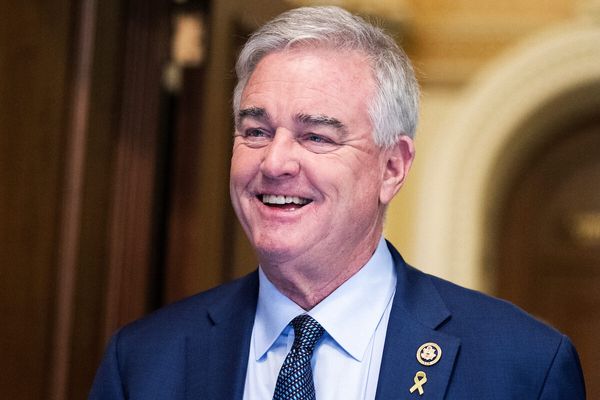
Crumbling a fistful of sandy soil by his dried-up sunflower field, Thomas Goebel pointed to one of the many casualties of this year’s drought: a bright green machine that resembles a tractor crossed with a biplane.
The Gurkenflieger (cucumber plane) used to roll proudly through his fields with farmhands in the wings plucking vegetables to make salty-sweet-sour Spreewald gherkins. Goebel stopped using it for production five years ago – his pickles could not compete with supermarket prices – and a recent experiment letting tourists ride inside generated enthusiasm but little profit.
Now, the Gurkenflieger joins the ranks of ageing machines and four hectares of woodland that Goebel has sold off to manage a lack of liquidity as bank loans and employee salaries collide with volatile weather. This year’s drought has dried out his crops and cut yields by 40-75% of the average for the last two decades.
“It makes your heart pound,” said Goebel, a self-described optimist who chairs the south Brandenburg farmer’s association, about the hot and dry weather that withered his plants this year.
“Every day on the way from home to the fields I had to watch the sunflowers and corn curl up and shrink,” he said. “I had to drive with blinders on. I couldn’t look left or right.”
Stories such as Goebel’s are becoming more common across the continent. Drought has cost Europe a staggering €11.2bn (£9.8bn) a year over the last few decades, a study found earlier this summer, and losses are set to mount as fossil fuel pollution clogs the atmosphere.
Annual drought losses in the EU, the UK, Norway and Switzerland are projected to rise to €13bn (£11.3bn) if global heating reaches 2C (3.5F) above pre-industrial – an optimistic outcome based on current policies – and €17.5bn (£15.3bn) if it hits a catastrophic 3C (5F).
The food system is the most vulnerable. Lilian Guzmán, a farmer just outside Berlin, said the drought had led to a “total failure” of her rapeseed crop and left her and her employees wishing for rain as the harvest edged closer.
“It was a huge stress,” said Guzmán, who like Goebel has sandy soils that struggle to hold water. “We were watching from the window like children waiting for the first snow.”
Adam Beer, an organic farmer in south-west England, said he hadn’t seen proper rain for months when he planted cabbages and cauliflowers in the wake of the heatwave that scorched Europe in early July. He made sure to irrigate his field once before and twice after placing the four-inch shoots in the frail soil.
But within a week, he said, the young green plants had turned “either completely invisible, or so dry you could crumble them into dust.”
Beer had expected to lose half the crop to the hot and dry weather but instead found 95% had been wiped out. “Your heart just drops,” he said. “It’s devastating.”
From the UK, which saw its driest spring in over a century, all the way through to Ukraine, a breadbasket facing desertification, the lack of water has also caused pain across lesser-known parts of the European economy.
“It is indeed stressful,” said Martin Staats, president of the German inland shipping association. Low water levels were restricting movement and stopping companies from loading their ships full of cargo, he said. In the driest periods, ships have been forced to sit idly in harbours.
“If I compare it to Covid or with other economic challenges we face in the shipping industry, the drought is the biggest problem,” said Staats. “It’s not forecastable, it’s not foreseeable, and we cannot adapt the vessels.”
The economic fallout of drought has been seen most clearly on the Rhine, which links Germany’s industrial heartland with Rotterdam, Europe’s biggest port. In 2018, the river was too hot to cool industrial facilities and water levels were too low to ship raw materials or goods. The drop in production cost German chemical firm BASF €250m (£218m).
Svenja Paul, a financial spokesperson for Covestro, a smaller German chemical company, said their losses from the drought that year were lower – “in the mid-double-digit million-euro range” – and that the company has invested in measures that have allowed it to avoid “significant disruptions” in recent years with little water.
“To deal with fluctuating water levels, we have established a dedicated taskforce that monitors forecasts and coordinates countermeasures,” she said. “[These range] from deploying additional ships and building up inventories to shifting transport to rail or road.”
Other sectors are struggling to adapt. France and Switzerland were forced to shut down nuclear power plants during the June heatwave because of a lack of water cold enough for cooling. At the same time, power-generating dams across the continent have been left with reservoirs that are far emptier than last year.
Europe’s hydropower generation typically peaks in May, as snow melts and spring showers fill streams and rivers, but in 2025 output fell to its lowest level for the month since 2017, according to data from thinktank Ember. In July, British energy company SSE blamed “unfavourable weather conditions across April and May” for a drop in total production that included a year-on-year fall in springtime hydropower generation of 40%.
Some regions have seen a respite from recent rains, while others are still on edge. One-third of Europe was under orange drought warnings at the end of June, and by August red alert conditions had set in across large parts of south-west France and the Balkans.
The lack of rain has squeezed farmers across the continent who are weighed down by other burdens and have little room to breathe. Svitlana Lytvyn, chief analyst at the Ukrainian Agribusiness Club, said the weather this year has been “particularly disappointing” for Ukrainian farmers. There would still be enough food to meet domestic demand, she said, but it may lead to a fall in agricultural exports – a key pillar of the war-torn country’s economy.
For Beer, the organic vegetable and crop farmer in England, this year’s losses also raise the question of how to prepare for the future. He said the death of his cauliflowers and cabbages this month will cost him 5-10% of the farm’s yearly income – a hit that comes on top of a dip in harvest yields for other crops, and which is set to be compounded by further losses this winter.
“The result of this is potentially less money to pay ourselves, but it definitely means less money for investments,” he said. “It means we can’t build resilience.”
• This article was amended on 28 September 2025. Increases of 2C and 3C are equivalent to increases of 3.5F and 5F respectively, not of 36F and 37F as an earlier version said due to an error introduced during editing.







